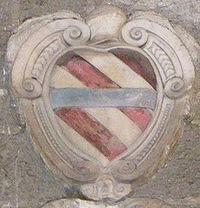
Corsini
Encyclopedia

History
The founder is said to be Neri Corsini, who came to prominence circa 1170. The family are likely to have originated from Corsica, during the time when the Republic of Pisa was ruling the island. Initially the family was known as Corso (from Corsica) then Corsino and finally Corsini. Like other Florentine nobles the Corsini initially had no titles, but in more recent times they received many from foreign potentates and from the later grand dukes of TuscanyTuscany
Tuscany is a region in Italy. It has an area of about 23,000 square kilometres and a population of about 3.75 million inhabitants. The regional capital is Florence ....
.
Saint Andrew Corsini (1302—1373) was a member of this family.
The Holy Roman Emperor Charles IV
Charles IV, Holy Roman Emperor
Charles IV , born Wenceslaus , was the second king of Bohemia from the House of Luxembourg, and the first king of Bohemia to also become Holy Roman Emperor....
made the head of the house a Count palatine
Count palatine
Count palatine is a high noble title, used to render several comital styles, in some cases also shortened to Palatine, which can have other meanings as well.-Comes palatinus:...
in 1371; the marquisate of Sismano
Sismano
Sismano, a little medieval borgo, is a frazione of the Italian commune of Avigliano Umbro, in the province of Terni. Sismano lies 13 km from Todi and 5 km from Avigliano; according to the Italian state census of 2001, Sismano has 17 inhabitants in the densely built historic center and 308...
was conferred on them in 1620, those of Casigliano and Civitella
Civitella in Val di Chiana
Civitella in Val di Chiana , often also Civitella di Val di Chiana, is a comune in the province of Arezzo, south of Arezzo in Tuscany, Italy. It is one of the best-preserved of the network of Lombard fortresses of the 6th and the 7th century in central Italy, strategically placed to control the...
in 1629, of Lajatico
Lajatico
Lajatico is a comune in the Province of Pisa in the Italian region Tuscany, located about 50 km southwest of Florence and about 40 km southeast of Pisa. As of 31 December 2004, it had a population of 1,353 and an area of 72.3 km²...
and Orciatico in 1644, of Giovagallo and Tresana
Tresana
Tresana is a comune in the Province of Massa-Carrara in the Italian region Tuscany, located about 120 km northwest of Florence and about 25 km northwest of Massa...
in 1652.
In 1730 Lorenzo Corsini was elected pope as Clement XII, made a nephew (a true nepote) Cardinal Neri Corsini, and conferred the rank of Roman princes and the duchy of Casigliano on his family; in 1732 they were created Grandees of Spain
Spain
Spain , officially the Kingdom of Spain languages]] under the European Charter for Regional or Minority Languages. In each of these, Spain's official name is as follows:;;;;;;), is a country and member state of the European Union located in southwestern Europe on the Iberian Peninsula...
.
They owned two palaces in Florence, one of which on the Lungarno Corsini (see Palazzo Corsini
Palazzo Corsini
The Palazzo Corsini is a prominent late-baroque palace in Rome, erected for the Corsini family between 1730-1740 as an elaboration of the prior building on the site, a 15th-century villa of the Riario family, based on designs of Ferdinando Fuga. It is located in the Trastevere section of the city,...
) contains the finest painting galleries in the city, and many villas and rural estates in various parts of Italy, including Prato
Prato
Prato is a city and comune in Tuscany, Italy, the capital of the Province of Prato. The city is situated at the foot of Monte Retaia , the last peak in the Calvana chain. The lowest altitude in the comune is 32 m, near the Cascine di Tavola, and the highest is the peak of Monte Cantagrillo...
.
Sources and references
- L. Passerini, Genealogia e storia della famiglia Corsini (Florence, 1858)
- A. von Reumont, Geschichte der Stadt Rom (Berlin, 1868)
- Almanach de GothaAlmanach de GothaThe Almanach de Gotha was a respected directory of Europe's highest nobility and royalty. First published in 1763 by C.W. Ettinger in Gotha at the ducal court of Frederick III, Duke of Saxe-Gotha-Altenburg, it was regarded as an authority in the classification of monarchies, princely and ducal...
. (passim)

